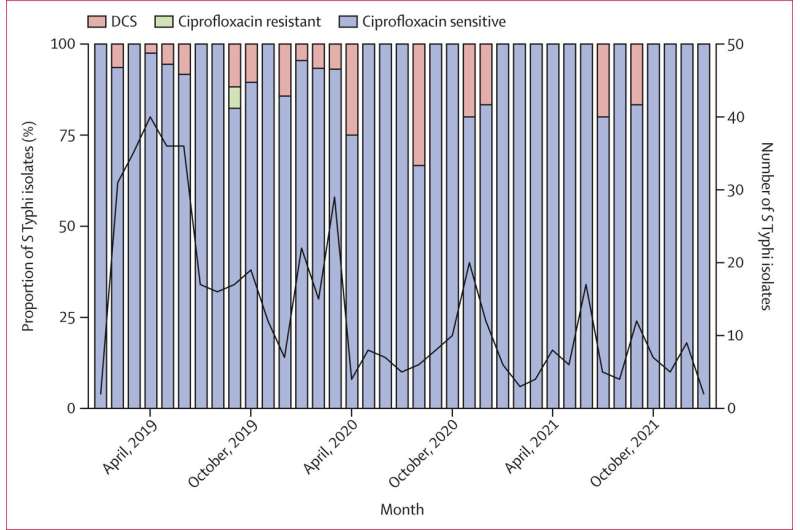This article has been reviewed according to Science X's editorial process and policies. Editors have highlighted the following attributes while ensuring the content's credibility:
fact-checked
peer-reviewed publication
trusted source
proofread
Study identifies increase in antibiotic-resistant typhoid

A study in Malawi has shown that shortly after an increase in antimicrobial use—specifically the antibiotic ciprofloxacin—rates of antimicrobial-resistant Salmonella typhi increased.
The findings are presented in a research paper authored by researchers from the Malawi-Liverpool Wellcome Program published in The Lancet Microbe.
Ciprofloxacin is the first-line drug for treating typhoid fever in many countries in Africa with a high disease burden, but the emergence of non-susceptibility poses a challenge to public health programs. Through enhanced surveillance as part of vaccine evaluation, the researchers investigated the occurrence and potential determinants of ciprofloxacin non-susceptibility in Blantyre, Malawi.
The researchers identified an association between the proportion of Salmonella enterica serotype Typhi (S Typhi) with a drug-resistant mutation in the quinolone resistance-determining region (QRDR) and the number of ciprofloxacin prescriptions in the previous month. They used whole genome sequencing to identify that S Typhi isolates with mutations evolved locally from the endemic S Typhi population in Blantyre, Malawi, and were not the result of importations from other countries.
Dr. Philip Ashton from the Malawi-Liverpool Wellcome Program said, "The most plausible explanation for this is that the increase in antimicrobials caused the emergence of resistance. Better diagnostics and good vaccines for typhoid will be key to reducing antimicrobial usage, and preventing resistance emerging. Fortunately, an effective vaccine has been recently been rolled out across Malawi.
"Antimicrobial resistance is one of the biggest threats facing humanity in the 21st century, and it will fall disproportionately on countries like Malawi. Currently, our understanding of antimicrobial resistance is based largely on data from high-income countries, and that knowledge may not translate to lower-income settings like Malawi. We urgently need more research on antimicrobial resistance in countries like Malawi to arm us with the understanding to tackle this deadly threat."
The researchers conducted systematic surveillance of typhoid fever cases and antibiotic prescription in two health centers in Blantyre, Malawi, between 2016 and 2019, as part of the STRATAA and TyVAC studies. In addition, blood cultures were taken from eligible patients presenting at Queen Elizabeth Central Hospital, Blantyre as part of routine diagnosis.
Between October 1, 2016, and August 31, 2019, of 177 typhoid fever cases confirmed by whole-genome sequencing, four (2%) were caused by S Typhi with QRDR mutations, compared with six (33%) of 18 cases between Sept 1, 2019, and Oct 31, 2019.
This increase was associated with a preceding spike in ciprofloxacin prescriptions. Every additional prescription of ciprofloxacin given to study participants in the preceding month was associated with a 4.2% increase in the relative risk of isolating S Typhi with a QRDR mutation.
More information: Philip M Ashton et al, Evaluating the relationship between ciprofloxacin prescription and non-susceptibility in Salmonella Typhi in Blantyre, Malawi: an observational study, The Lancet Microbe (2024). DOI: 10.1016/S2666-5247(23)00327-0





















